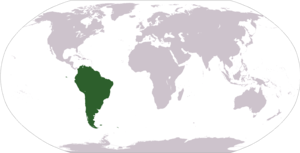In terms of language and culture, South America is close to southern Europe. Around half of the residents speak Portuguese (Brazil) or Spanish (in almost all other countries). Nevertheless, some of the dialects differ significantly from the languages known from Europe. In addition, there are the native American languages of the indigenous people, which are still spoken by part of the rural population, especially in the Andean region and in the central part of South America.
The largest country in South America is also the largest Portuguese-speaking country in the world. Numerous regionalisms have flowed into Brazilian, which give the local dialect a special character. So the debate seems broader than in Portugal. English is easy to get along with in the tourist centers, but in the inland the level of English is often poor, even though it is taught in schools. In the south, Spanish is also understood and, in part, Guaraní (in the remote border areas with Paraguay).
The Spanish of the Andean countries is comparatively easy to understand because it is quite close to traditional Spanish. But native languages are still widespread in rural areas in these countries. In the highlands these are mainly Quechua and Aymara, in the Amazon region Guaraní dialects and splinter groups. You can also get by with English in big cities and tourist centers.
In the northwest of South America, relatively pure Spanish is spoken with a few special expressions. The indigenous languages here are limited to remote areas and are used almost exclusively in oral communication. English is understood by the educated population in the cities.
Spanish has moved furthest away from Castilian in Argentina and Uruguay. There the grammar is also used differently: Der voseo, the replacement of the tú through the old Spanish vos, has gone into the standard language here. In Chile and Paraguay, Spanish is more traditional, but it still has some special terms. Special features are the Low German of the Mennonites in northwest Paraguay and Mapdungun in the south of Chile and Argentina, an old Indian lingua franca that is still spoken and spoken by around a million people. British English is spoken in the Falkland Islands.
Linguistically and culturally, the Guayanas occupy a special position in South America. The two small states and the French overseas department have always been more connected to the Caribbean than to the rest of the continent. The official languages are English in Guyana, Dutch in Suriname and French in French Guiana, but there are also Creole languages, especially that Sranan Tongo in Suriname, very common. Because of the large number of Asian immigrants, Hindi in Guyana and Indonesian in Suriname are also widespread.

The voseo is a peculiarity of South American Spanish, which is particularly widespread in Argentina, Uruguay, Paraguay, Chile and southern Bolivia, but also appears in the other Spanish-speaking countries. It is the replacement of the tú by vos, an alternative You-Form (2nd person singular) in verbs. In standard Spanish, the word is vos extinct, it originally had a meaning similar to the old German politeness form your. Quite the opposite of this vos mostly used as an informal, friendly you-form, the formal salutation is as in standard Spanish usted.
How do you form the vos-Verb forms? Fortunately, the conjugation is very regular and is derived directly from the verb stem (basic form without ending). There are only two exceptions: ser (vos SOS) and haber (vos has). In the present tense:
- On verbs with -ar-Ending: -ás (e.g. contar -> vos contás)
- On verbs with -he-Ending: -it (e.g. podhe -> vos podit)
- On verbs with -ir-Ending: -ís (e.g. salir -> vos salís)
Venezuela is a special case, here the vos form is like the Spanish one vosotros-Form conjugated. In Chile, on the other hand, there is another variant in which all verbs with -ís, regardless of the ending, can be conjugated. There it will vos also colorful with that tú mixed, sometimes tú is used together with the vos verb form.
In the formal written language, the voseo only used in Argentina and Uruguay. In the other countries, the form should only be used in informal oral communication, even if it seems to be gaining popularity in the media.